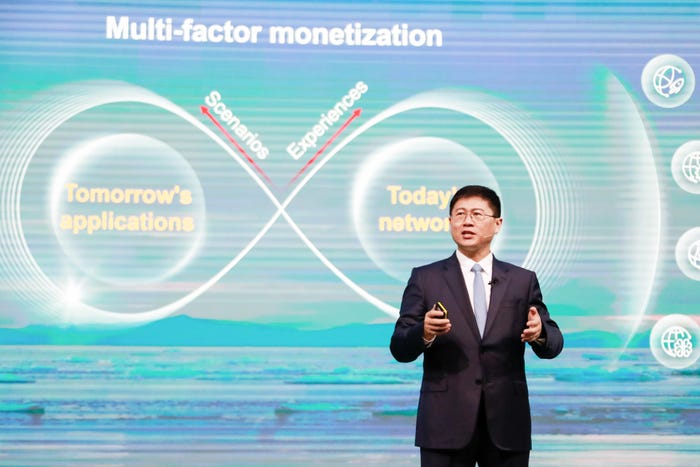Huawei maps out telco path to the intelligent economy with 5.5GHuawei maps out telco path to the intelligent economy with 5.5G
A fully intelligent world is fast approaching, opening the door to better customer experiences, new innovative services and more monetization possibilities for carriers. This was the upbeat message from Li Peng, Corporate Senior Vice President, President of ICT Sales and Service at Huawei, at Mobile World Congress.

A fully intelligent world is fast approaching, opening the door to better customer experiences, new innovative services and more monetization possibilities for carriers. This was the upbeat message from Li Peng, Corporate Senior Vice President, President of ICT Sales and Service at Huawei, at Mobile World Congress.
In his keynote presentation, “Advancing the Intelligent World”, Li spoke effusively about an already thriving digital economy that’s about to get turbo-charged by the intelligent economy, helped in no small measure by 5.5G, artificial intelligence (AI) and Internet of Things (IoT).
“The intelligent world is redefining information and value streams, unleashing the potential of ubiquitous connectivity,” Li added. “It will be more efficient to create, transfer and process information in the intelligent era.”

What does it all mean for carriers?
Li sees new value streams and business models, including customized bundles of services. He cited one carrier managing to increase ARPU through the launch of a special “5G livestreaming package”, which provides a guaranteed uplink (150Mbps or 200Mbps).
Li flagged 5G New Calling, too, which gives users high-definition and immersive audio and video communications. He gave an example of how 5G New Calling is being used to cut down the time to process a car insurance claim in the event of an accident through a mix of remote damage assessment, AR marking and view sharing. “The one-stop solution reduces the handling time from hours to minutes and consumers are happy to pay for it,” said Li. Use cases like this, he added, can help carriers monetize the B2B2C market.
“High-bandwidth and low-latency networks make it possible to push the boundaries of ubiquitous connectivity,” Li continued. “Now, intelligent vehicles can work non-stop and production systems can be controlled in real time. Everything can be connected, from roads to warehouses, from land to sea, and from cities to the most remote places on earth.”
More innovative applications like Livestreaming, Glasses-free 3D and cloud phone are on their way, highlighted Li, and carriers will be well placed to meet demand and boost ARPU if their networks are robust. “To have a good experience of these applications, guaranteed uplink, QoS and latency are a must,” he said. “This provides an opportunity for carriers to monetize mobile services beyond connectivity. It will open a hundred‑billion‑dollar market.”
Handling massive increases in data traffic volumes, spurred on by AI and generative AI (GenAI), will of course present huge challenges to carriers. By way of example on how data generation is exploding, Li noted that GenAI is expected to produce over 250 billion images in 2026 alone. That’s ten times the number of pictures humans created in the twentieth century.
New services in the consumer and business markets will therefore require stronger network capabilities, such as deterministic experience and passive IoT, continued Li. “For industrial applications, like smart grids and logistics, connection density and precision need to be raised by 10 times,” he said.
5.5G path towards an intelligent world
Since the demands of an intelligent world are exacting – the new norm will be uplink-centric broadband communication, real-time broadband communication, and all-scenario IoT – Li pointed out it will require a raising of the bar for networks. “So,” he said, “5.5G will be our path forward.”
“We are happy to see that pioneers are already paving the way [with 5.5G],” Li observed. “From China to the Middle East and Europe we are seeing more and more 10-gigabit smart cities. Leading carriers have already verified 5.5G capabilities on commercial networks. The tests cover a wide range of scenarios, including smart connections for people, homes, vehicles and stadiums.”
For Li, embracing 5.5G will build a solid foundation for the intelligent world. He highlighted various innovations that are already commercially available from Huawei that can support carriers’ 5.5G deployments, including ELAA (extremely large antenna array), up to five frequency bands consolidated on a single box (Huawei’s LampSite X), and continuous coverage with mmWave AAU.
Li also gave prominence to Huawei’s “Telecom Foundation Model”, unveiled this week at MWC. “[It is] the industry’s first AI foundation model for telcos,” said Li. “This model can help carriers grow revenue, improve O&M efficiency, and deliver better user experience.”
Rounding off his MWC keynote presentation, Li asserted that the intelligent world was just around the corner. “The opportunities are endless,” he said. “Let’s build today's networks for tomorrow's applications.”
About the Author
You May Also Like










.png?width=300&auto=webp&quality=80&disable=upscale)


_1.jpg?width=300&auto=webp&quality=80&disable=upscale)